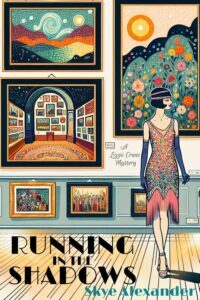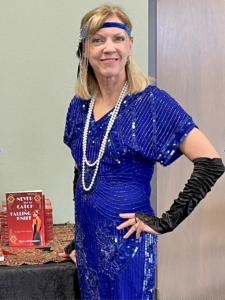Running in the Shadows: Author Guest Post
Running in the Shadows, a Lizzie Crane Mystery by Skye Alexander
Author Guest Post + Book & Author InfoRunning in the Shadows
 March 1926, Salem, Massachusetts
March 1926, Salem, Massachusetts
A spring equinox party at the mansion of a rich, flamboyant, and controversial art collector promises New York jazz singer Lizzie Crane and her band a fat paycheck, lucrative connections, and plenty of fun. She’ll also have an opportunity to reconnect with a handsome Boston Brahmin she fancies.
But the excitement she hopes for doesn’t turn out the way she expected. On the night of the musicians’ first performance, a naked young woman trots into the ballroom on horseback, sweeps up a talented artist named Sebastian, and rides off with him into the night. The next morning, Lizzie discovers the artist’s body tied to a tree, shot full of arrows like the martyred Saint Sebastian in Botticelli’s painting.
Soon Lizzie learns that her business partner, pianist Sidney Somerset, once had a close relationship with the dead man––and police suspect Sidney of murdering him. As she tries to protect her friend and discover the killer, Lizzie gets entangled in the treacherous underworld of art theft and forgery, a world where fantastic sums of money change hands and where lives are cheap.
To purchase Running in the Shadows, click either of the following links: Amazon & Barnes & NobleAuthor Guest PostClothes Make the Womanby Skye AlexanderThe fashion world is ever-changing, and in the 1920s when my Lizzie Crane mystery series takes place the clothes a woman wore not only expressed her sense of style but also the changing ideas and mores of the Jazz Age. Modern ladies were shedding outdated social roles and restrictions as fast as they cast off their corsets. Hemlines rose to previously shocking lengths, baring ankles and calves. Some daring young women even painted images of their beaus on their knees—their short skirts revealed the pictures when they danced the Charleston.
Glittery flapper dresses, resplendent with sequins and fringe, exposed plenty of skin. On the beaches, swimming costumes crept up high enough that policemen known as “beach censors” trod the sand, measuring ladies’ legs to make sure no more than six inches of flesh showed between hem and knees.
Wearing trousers, too, signaled not only a desire for comfort and convenience, but a shift toward equality between women and men as well. In most circles at that time, a lady dressed in pants raised eyebrows. Some towns in the Midwest and South even outlawed wearing trousers and fined brazen women for doing so.
In the first novel in my Lizzie Crane mystery series, Never Try to Catch a Falling Knife, my jazz singer heroine from Greenwich Village gets off to a rocky start her first day on the job by wearing trousers when she meets her conservative Yankee employer. Sportswomen, however, were grudgingly allowed to don knickers on the golf course or men’s white trousers while playing tennis.
Although off-the-rack pants for ladies weren’t available in the early ’20s, the 1927 Sears catalog offered tweed woolen knickers to golfing girls for $2.98. If you wanted something more in line with what Katherine Hepburn popularized a decade later, you had to have them custom-made or buy men’s and alter them yourself.
The Inside Scoop on Intimate Attire
As women’s outer garments changed, so did their underwear. No longer confined by tight corsets and multiple petticoats, liberated ladies shed the many layers their mothers wore in favor of slinky teddies, camisoles, and bloomers that slid comfortably beneath their slim-fitting dresses. Nylon, polyester, and other synthetic materials didn’t exist at that time, so wealthy women chose undies made of silk whereas ladies of lesser means garbed themselves in cotton, rayon, and wool. Instead of only boring white, lingerie now became available to style-conscious women in pink, peach, beige, light green, and naughty black.
Prior to the Roaring Twenties, women wore thick stockings primarily for warmth. Now, with their legs on display in their new short skirts, modern ladies switched to sheer stockings that showcased their calves. Silk stockings were the preferred choice for those who could afford them at $1.48/pair in 1925 (the equivalent of about $25 in today’s money), in colors ranging from champagne to black. Rayon provided a cheaper alternative for cost-conscious women––and if they objected to the material’s sheen, they dusted their legs with powder to soften it.
Women who still chose to wear girdles clipped their stockings to attached garters. Free-spirited fems rolled their stockings into place and fastened them just above the knee with elastic bands. The bands, sometimes called “jazz garters,” soon became a fashion statement in themselves, decorated with lace, ribbons, and rhinestones in sexy colors such as purple, red, and black. And if a woman wanted to keep a nip nearby in defiance of Prohibition, she could wear a garter flask that featured a pocket with a small silver container to hold her drink of choice.
Shopping for Clothes in the Roaring Twenties
Prior to the 1920s, most women made their own clothes. But as more entered the workforce during the Jazz Age—half of single women were employed outside the home in 1930—they had less time to devote to sewing. In response to this trend, department stores such as Macy’s and Bergdorf Goodman began selling off-the-rack garments. Now, busy ladies could purchase ready-made dresses, coats, and other clothing rather than engage in the time-consuming task of creating their own wardrobes or paying seamstresses to fabricate them.
For people who couldn’t afford to buy at upscale department stores, a shopping alternative arose during the 1920s: thrift shops.
Prior to this time, peddlers hawking used clothing and other goods were common in America’s cities and towns—especially in less affluent neighborhoods. Many of these merchants were Jewish immigrants. But during the twenties, Christian churches began establishing outlets to sell clothing and other products donated by parishioners with the goal of raising money for their churches.
Goodwill trucks collected used clothing from more than a thousand households in the Twenties and proceeds from thrift stores funded half the Salvation Army’s budget. Chanteuse Lizzie Crane, my style-savvy protagonist, realizes that the wealthy ladies for whom she performs wouldn’t be caught dead wearing the same evening gown twice, and she buys most of her attire secondhand at church charity stores.
Hemlines and the Economy
Not only do the clothes a woman wears reveal her personal tastes, social class, and ideology, they may also be an indication of the economy. According to the “Hemline Index,” skirts rise during periods of prosperity and lengthen during leaner times. The short skirts of the Twenties celebrated a post-war boom as well as newfound freedoms for women. During World War II and the recession that followed, women’s hemlines dropped again. When times were good in the 1960s, the fashion world gave us the miniskirt and the bikini.
That’s not to say investors should take tips from haute couture—it’s likely that the fashion industry follows economic trends rather than predicting them. But perhaps something more than personal taste or vanity influences a woman’s choice of clothing. Risqué styles reflect a sense of playfulness, confidence, and freedom from limitations or worries, whereas more serious garb suggests a desire for protection, endurance, and the security of tradition.
Whether or not these psychological connections have any merit, certainly the Roaring Twenties transformed the way women thought of themselves and their place in the world—and their clothes reflected that transformation.
 Skye Alexander — Author of Running in the Shadows
Skye Alexander — Author of Running in the Shadows[image error]Skye Alexander is the author of nearly 50 fiction and nonfiction books. Her stories have appeared in anthologies internationally, and her work has been translated into fifteen languages.
In 2003, she cofounded Level Best Books with fellow crime writers Kate Flora and Susan Oleksiw.
So far her Lizzie Crane mystery series includes four traditional historical novels set in the Jazz Age: Never Try to Catch a Falling Knife, What the Walls Know, The Goddess of Shipwrecked Sailors, and Running in the Shadows.
After living in Massachusetts for thirty-one years, Skye now makes her home in Texas.
To learn more about Skye, click on either of the following links: Website & FacebookElena Hartwell / Elena Taylor

The post Running in the Shadows: Author Guest Post appeared first on The Mystery of Writing.



